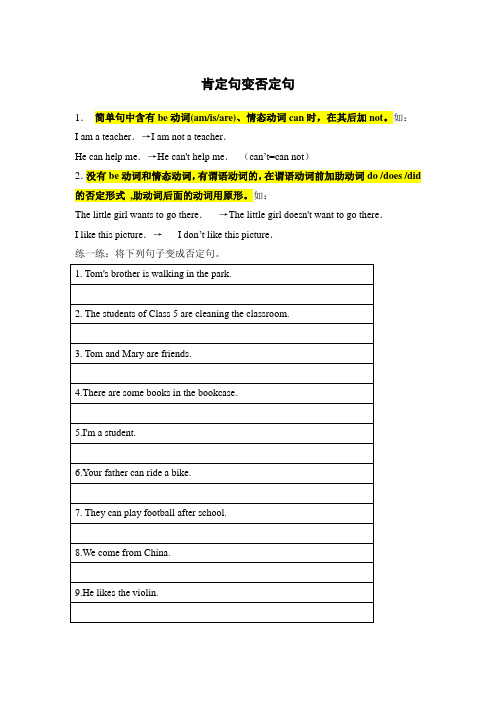小学英语 否定句
- 格式:pptx
- 大小:314.76 KB
- 文档页数:16

肯定句变否定句1.简单句中含有be动词(am/is/are)、情态动词can时,在其后加not。
如:I am a teacher.→I am not a teacher.He can help me.→He can't help me.(can’t=can not)2.没有be动词和情态动词,有谓语动词的,在谓语动词前加助动词do /does /did 的否定形式,助动词后面的动词用原形。
如:The little girl wants to go there.→The little girl doesn't want to go there.I like this picture.→I don’t like this picture.练一练:将下列句子变成否定句。
1. Tom's brother is walking in the park.2. The students of Class 5 are cleaning the classroom.3. Tom and Mary are friends.4.There are some books in the bookcase.5.I'm a student.6.Your father can ride a bike.7. They can play football after school.8.We come from China.9.He likes the violin.3.祈使句变否定句时,一般在句首加Don't,但Let us或Let's开头的祈使句在Let us或Let's后加not即可。
如:Put them over there.→Don't put them over there.Let us go home.→Let us not go home.4.主从复合句中,主句是I think,I believe等结构,变否定句时,形式上否定主句,实际上否定从句。

英语改为否定句的口诀
以下是英语改为否定句的口诀:
1.在助动词前加not,例如:I am going to the store.(我要去商店。
)→I am not going to the store.(我不打算去商店。
)
2.对于一般现在时和一般过去时,在主语后面加上not,例如:She sings beautifully.(她唱得很美。
)→She does not sing beautifully.(她唱歌不好听。
)
3.对于情态动词,在动词前加上not,例如:You can speak English well.(你英语说得好。
)→You cannot speak English well.(你英语说得不好。
)
4.对于某些动词,需要在前面加上do或does not,例如:He studies hard.(他学习很努力。
)→He does not study hard.(他不认真学习。
)
需要注意的是,有些动词的否定形式比较特殊,需要单独记忆,例如:have、has、had、will、would等。


小学英语肯定句、否定句、一般疑问句和特殊疑问句的详解一、be动词:am, is, are二、肯定句、否定句、一般疑问句和特殊疑问句定义1.肯定句:表示肯定的意思, 即不含有否定词“不”。
比如:我是一个学生 I am a student.他去上学 He goes to school.2.否定句:表示否定的意思。
比如:我不是一个男孩。
I am not a boy他不去上学 He does not go to school.3. 一般疑问句:回答为“是yes”或者“否no”的问句。
比如:你是一个学生吗? Are you a student?你喜欢英语吗? Do you like English?4. 特殊疑问句:回答不是“是yes”或者“否no”的问句,根据提问内容具体回答。
比如:现在几点了? What’s the time?哪一支笔是你的? Which is your pen?肯定句变否定句:在am, is, are后面加上not,其余按顺序照抄。
肯定句变一般疑问句:把am, is, are提前放到句首并大写Am, Is, Are,其余照抄。
肯定句变特殊疑问句(就划线部分提问):分3步骤第一步:先变一般疑问句第二步:找合适的特殊疑问词代替划线部分第三步:特殊疑问词提前放到句首,并大写,其余按顺序照抄,省略划线部分。
注意:1.如:Li ming 's not here today. Who's not here today? 今天谁没来?2.例如:1.肯定句、否定句和一般疑问句的互换肯定句:This is a book.否定句:一般疑问句:Is this a book?肯定回答:Yes, it is.否定回答:No, it isn’t.2.就划线部分提问(变特殊疑问句)This is a book.第一步:变一般疑问句 Is this a book?第二步:找合适的特殊疑问词 Is this what ?特殊疑问词提前放到句首,并大写,其余按顺序照抄,省略划线部分。


英语肯定句否定句一般疑问句和特殊疑问句Ting Bao was revised on January 6, 20021小学英语肯定句、否定句、一般疑问句和特殊疑问句一、be动词:am, is, are二、肯定句、否定句、一般疑问句和特殊疑问句定义1.肯定句:表示肯定的意思,即不含有否定词“不”。
比如:我是一个学生?I am a student.他去上学?He goes to school.2.否定句:表示否定的意思。
比如:我不是一个男孩。
I amnota boy他不去上学He doesnotgo to school.3.一般疑问句:回答为“是yes”或者“否no”的问句。
比如:你是一个学生吗Are you a student你喜欢英语吗Do you like English4.特殊疑问句:回答不是“是yes”或者“否no”的问句,根据提问内容具体回答。
比如:现在几点了?What’s the time?哪一支笔是你的Which is your pen三、肯定句、否定句、一般疑问句和特殊疑问句的相互转换有am, is, are的句子,肯定句变否定句:在am, is, are后面加上not,其余按顺序照抄。
肯定句变一般疑问句:把am, is, are提前放到句首并大写Am, Is, Are,其余照抄。
肯定句变特殊疑问句(就划线部分提问):分3步骤第一步:先变一般疑问句第二步:找合适的特殊疑问词代替划线部分第三步:特殊疑问词提前放到句首,并大写,其余按顺序照抄,省略划线部分。
注意:1.一定先变一般疑问句。
但是,如果问的是主语或主语的定语时,语序不变,为"特殊疑问词(+主语)+陈述句"。
如:Li ming's not here today. Who's not here today今天谁没来2.1.肯定句、否定句和一般疑问句的互换肯定句:This is a book.否定句:This isnota book.一般疑问句:Is this a book?肯定回答:Yes, it is.否定回答:No, it isn’t.2.就划线部分提问(变特殊疑问句)This is?a book.第一步:变一般疑问句Is thisa book第二步:找合适的特殊疑问词Is thiswhat第三步:特殊疑问词提前放到句首,并大写,其余按顺序照抄,省略划线部分。